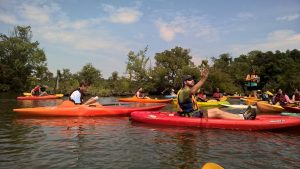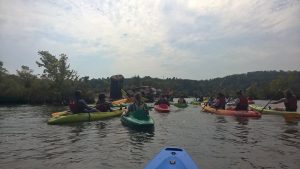Our entourage of delicate kayaks dot the surface of the water, like gerridae, as we slide around the lagoon. The view of the Dominion coal plant that looms ominously on the horizon is broken only by the flash of our kayak paddles in the air. The immediate foreground is a wildlife haven full of greens and blues; however, the backdrop decants smoke and steam high into the sky. Where are we? What inexplicable heterotopia spans across this bizarre environment?
Although fringed by a Dominion coal plant, Dutch Gap, located in the county of Chesterfield, VA, is currently a conservation area. During the Civil War, union soldiers carved out the land in order to maneuver around a corridor of the James that was then controlled by confederate troops. After the war, the channel was widened and quickly became a ‘shortcut’ for trade routes on the James. Between the 1920’s and the 1960’s, the area was used as a gravel mine, which can easily be imaged today as parts of the Gap are still filled with tug boats, barges and crumbling industrial waste. Currently, Dutch Gap serves its original guests by providing habitat, food, water and natural cycles for both terrestrial and aquatic flora and fauna.
The basic history of the Gap paints a success story of a misused space that was overwhelmed, overused and confounded by anthropocentric needs, ultimately saved and restored to its former wild glory. However, the reality that saturates Dutch Gap is far from this perfect restoration tale. In truth, the Gap is a heterotopia and somehow balances the newly reestablished landscape with a polluted past producing a converged environment incorporating both wildlife and industry. The invisible heat from Dominion’s effluence keeps the water unnaturally warm all year around; however, fishermen still trace the shoreline with their rods in hope of snagging a largemouth bass. The decaying wood and metal of the barges pierces the landscape, but the foliage simply grows around it as if it is captaining the boats now. The Richmond Times-Dispatch ran a front page story about Dominion’s unsafe coal ash ponds and their degrading impact on the Gap just days after our excursion, but king fishes, great blue herons, beavers, otters and other wildlife continue to dwell within the lagoon.
Dutch Gap is truly an intricately multifaceted heterotopia that miraculously unites a wildlife haven and an industrial wasteland. While this is astounding, is it admirable? Is it beneficial for the environment? Is it beneficial for humans? What has been accomplished by the Gap converging these radically dissimilar worlds? While it unites two opposites, thus adequately serving two separate needs, it also fails to fully provide for either of the needs. Should each realm be relegated to one area or can they share the space? The confusion continues as we weave in and out of the islands in our kayaks, threading the questions that whet our minds.


